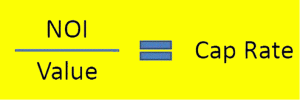So many people in real estate think there is only one cap rate. Did you know there are at least 3 real cap rates and a bunch of “estimated” cap rates? Let’s count the real ones.
- Using the seller’s last year income (like what assessors use) and current year sale price
- Using the seller’s proforma 12 month or partial current year income projected for 12 months
- Using the buyer’s proforma 12 month projection
Now let’s count the “estimated” ones:
- The cap rate shown from a data source that you buy your comparable from (the tip-off is they show rounded vacancy and expense numbers like a 5 percent vacancy and a 40 percent operating expense ratio or dollar expenses that are perfectly round like $10,000 for real estate taxes)
- In non-disclosure states where sale prices are not shown on deeds, the buyer can give you one sale price and the seller another, so no matter how you estimate income and expenses, the sale price could vary and hence the cap rate.
 So, how do you know what cap rate is best? Obviously, the first is more reliable than the last two, but sadly most people always want to take the easy way out. They don’t want to call the participants to find out the cap rate – they’d rather buy the comparable and use the cap rate reported in the sale data verbatim. I’m amazed that in many of my tax appeals, the assessor whips out the cap rate from a third party data source, it’s just “estimated” as discussed above, and they rely on it without question. They’ll even defend the work of someone else tooth and nail.
So, how do you know what cap rate is best? Obviously, the first is more reliable than the last two, but sadly most people always want to take the easy way out. They don’t want to call the participants to find out the cap rate – they’d rather buy the comparable and use the cap rate reported in the sale data verbatim. I’m amazed that in many of my tax appeals, the assessor whips out the cap rate from a third party data source, it’s just “estimated” as discussed above, and they rely on it without question. They’ll even defend the work of someone else tooth and nail.
The sad thing about all this, and the point I wish to make, is that reality usually mirrors perception. You assume the cap rate is right from the data you buy even though there are all these disclaimers associated with its purchase (like they don’t assume liability for any of the data reported). You do remember the old Odd Couple episode when Felix Unger said that when you assume, you make an ass out of u and me?
When enough people believe it, it becomes the cap rate. Perpetuate a lie long enough and you start to believe it. That’s when the cap rate becomes the crap rate.

